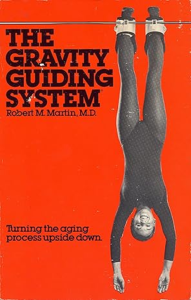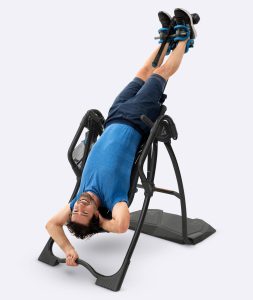As sedentary lifestyles, muscle strain, and spinal problems become increasingly common in modern society, an ancient yet modern “reverse therapy” — the inversion table — is regaining popularity. By reversing gravity’s effect on the body, it helps decompress the spine, relax muscles, and improve circulation.
This article explores the working principles, medical rationale, and historical evolution of inversion tables — from ancient Greece to the modern fitness and rehabilitation era.
1. Working Principle and Medical Basis of Inversion Tables
An inversion table works by positioning the user upside down or at an inverted angle, using gravity to stretch the spine and reduce pressure.
This approach, known as Inversion Therapy or Spinal Traction, is based on the principle of using the body’s own weight to increase the space between vertebrae and relieve nerve compression.
When a person is inverted, the spine is no longer subjected to the usual downward compressive forces. The intervertebral discs can expand slightly, restoring shape and improving nutrient exchange, which helps relieve back pain and nerve-related symptoms. The process is similar to traction therapy in physiotherapy and chiropractic medicine — employing gravitational pull in the opposite direction to relax the muscles and ligaments surrounding the spine.
From a rehabilitation medicine perspective, inversion traction can temporarily reduce pressure on lumbar nerve roots, improve spinal alignment, and provide auxiliary relief for patients with lumbar disc herniation or degenerative spinal disorders.
Inversion also enhances blood and lymphatic circulation. When inverted, blood flows more easily to the torso and head. Studies have shown that mild inversion can increase overall circulation efficiency by about 15%–20%, benefiting people who sit for long hours or have poor venous return.
The technique promotes faster venous return from the legs, reduces gravity-induced swelling, and increases cerebral blood flow, helping improve alertness and balance. According to health research, regular use of inversion tables among middle-aged and elderly users has been associated with improved peripheral circulation and metabolism.
In addition, inversion provides significant muscle relaxation and flexibility benefits. During inversion, the back and core muscles are stretched, easing spasms and tightness, and improving the elasticity of soft tissues around the spine.
Many users report temporary relief from lower back pain and sciatica after inversion sessions, as well as increased flexibility. This mechanism resembles yoga inversion postures, which for thousands of years have been practiced to “rebalance the body,” “enhance circulation,” and “relax internal organs.”
It is important to note that the benefits of inversion therapy are generally short-term and supportive. Scientific studies remain divided: some small-scale trials suggest that inversion traction can temporarily alleviate pain, improve mobility, and even delay or prevent surgery in severe lumbar disc cases; others found no significant long-term benefits.
Therefore, inversion therapy should be regarded as a complementary physical therapy, not a universal treatment. It should be combined with other rehabilitation exercises under medical or physiotherapist supervision.
In particular, individuals with hypertension, cardiovascular disease, glaucoma, or pregnant women are advised not to use inversion therapy, as inversion increases intracranial and intraocular pressure.
Professionals recommend that beginners start at a low inversion angle and short duration, and perform the exercise under supervision to ensure safety.
2. Theoretical Origins and Historical Background
The concept behind inversion tables can be traced back to ancient times. As early as 400 BCE, Greek physician Hippocrates reportedly strapped patients to a wooden ladder and suspended them upside down to relieve spinal ailments — an early form of spinal traction therapy.
In the East, yoga practices dating back thousands of years emphasized inverted postures (such as headstands and shoulder stands) for their therapeutic value, believing that inversion could “balance bodily fluids,” “increase brain blood flow,” and “relax internal organs.” These ancient practices provided the philosophical and physiological foundation for modern inversion therapy.
With the rise of physical therapy and chiropractic science in the 20th century, researchers began exploring mechanical ways to safely achieve spinal traction — giving birth to the modern inversion table.
Traction therapy, long used as a conservative treatment for herniated discs and nerve root compression, was adapted into a home-friendly mechanical form through inversion devices.
In the early 1980s, clinical experiments demonstrated that using an inversion table at a 60° angle for several minutes, a few times per week, over an eight-week period, could improve lower back pain and flexibility.
One study reported that combining inversion traction with conventional therapy reduced the likelihood of surgery in patients with severe disc herniation. Although these studies were small in scale, they provided scientific validation** for inversion therapy.
Overall, the working mechanism of inversion tables aligns with established biomechanical and rehabilitation medicine principles regarding spinal decompression, which explains their growing acceptance in physiotherapy and home wellness applications worldwide.
3. Origins and Evolution of Inversion Tables
Early Concepts
The human fascination with inversion as a healing method dates back millennia. In addition to Hippocrates’ “spinal suspension” therapy and India’s yoga inversions, traditional Chinese wellness practices also included “Dao Gua Jin Gou” (Hanging by the Heels) — a method of hanging upside down to strengthen the body.
These early forms relied mainly on manual support, ropes, or bars, far from the mechanical precision of today’s equipment.
Early Prototypes
In the early 20th century, as anatomy and rehabilitation sciences advanced, inventors began developing controlled inversion devices.
The first patent related to inversion traction was filed in 1902. In 1946, American inventor May MacGregor patented the “Rest and Exercise Board,” regarded as an early prototype of the modern inversion table.

By the mid-20th century, slant boards became popular in the U.S. and Europe.
Nutritionist Bernard Jensen promoted “Slant Board Therapy” throughout the 1940s–1980s, teaching users at his California health retreats to recline on angled boards to improve posture and circulation.
He also authored The Slant Board: A New Angle to Health and Beauty, which popularized the idea of gentle inversion as a wellness practice.
In the 1950s, the “Hollywood Slant Board” became a beauty trend among movie stars such as Olivia de Havilland and Ginger Rogers. Major department stores like Sears marketed these boards as home wellness and beauty devices.
The Birth of the Modern Inversion Table
The true modern inversion table emerged in the 1960s–1970s, led by American chiropractor Dr. Robert Martin in California. He introduced the concept of the “Gravity Guidance System”, promoting inversion as a way to “counteract the effects of gravity on aging.” Through TV appearances and public lectures, Dr. Martin brought inversion therapy into mainstream awareness.

His son, Robert Martin Jr., further commercialized the concept in the late 1970s with his book Gravity Guidance and a line of consumer inversion tables, marking the start of the inversion equipment industry.
Other designs soon followed, such as Bud Leach’s BackSwing model, refining the A-frame structure with a pivoting backrest that defines modern inversion tables today.
Boom and Decline
The early 1980s marked the first major boom for inversion equipment in North America. By 1982, the U.S. inversion table market was valued at USD 70 million, with over 40 manufacturers competing.
However, rapid expansion led to inconsistent product quality and safety issues. Some low-cost models suffered from weak welds or structural failure, causing serious accidents and injuries. At the same time, sensationalized media reports linked inversion to stroke risk after a single medical study found temporary increases in blood pressure during inversion.
Although the study’s author later clarified that no evidence of stroke risk existed in long-term use, public confidence plummeted. By the mid-1980s, the inversion industry had virtually collapsed, surviving only in specialized chiropractic and athletic rehabilitation settings.
Recovery and Innovation
After nearly a decade of stagnation, inversion tables regained recognition in the late 1990s as part of a broader “wellness and self-care” movement.

American brand Teeter became a key driver of this revival. Founded by Roger and Jennifer Teeter, the company focused on engineering improvements and safety standardization, introducing stronger materials, better ankle locking systems, and passing the rigorous UL 1647 Safety Certification. Teeter’s persistence helped rebuild public trust, re-establishing inversion tables as legitimate wellness equipment rather than a fitness fad.
By the early 2000s, inversion tables were repositioned as home health and spinal care devices, and even adopted by the U.S. Army Physical Training School to help soldiers relieve spinal compression and muscle fatigue.
Entering the 21st century, the global inversion table market experienced renewed growth. While North America and Europe remain mature markets, Asia — especially China — is now the primary growth driver.
According to industry data, the global inversion table market was valued at USD 242 million in 2021, and is projected to reach USD 285 million by 2025, representing an annual growth rate of about 4–5%.The Asia-Pacific region accounts for roughly one-third of global demand, while North America and Europe each contribute about one-quarter.
China has become the leading global manufacturer and exporter, with export volumes up 15% year-on-year in 2023, primarily to the U.S. and European markets.
Conclusion
From Hippocrates’ ladder suspension to today’s precision-engineered inversion tables, the idea of using gravity in reverse has evolved from ancient philosophy to modern science.
While inversion therapy is not a cure-all, it offers a natural, accessible way to decompress the spine and promote overall well-being — a gentle reminder that sometimes, turning the world upside down can help us find better balance.


Comments (0)
No comments yet, be the first to comment!